Subscribe to the Newsletter
Your cart is empty
Shop now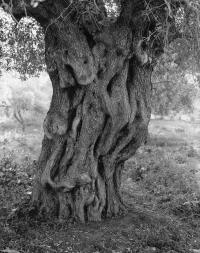

Collaborators Corner: A land memorial on Occupied Territories of Palestine by Adam Broomberg and Rafael Gonzales
“Anchor in the Landscape”: Adam Broomberg and Rafael Gonzales’ book capturing Palestinian identity through millenary olive trees
The olive tree symbolizes Palestinian identity, culture, and resistance. It sustains the livelihoods of more than 100,000 Palestinian families, serves as a cornerstone of traditions and identities, and has long been a target of destruction and theft. Since 1967, Israeli authorities and settlers have destroyed 800,000 Palestinian olive trees. Over the past eighteen months, photographers Adam Broomberg and Rafael Gonzalez have been capturing images of olive trees in the Occupied Territories of Palestine, many of which are thousands of years old.
The book “Anchor in the Landscape” combines their thoughtful and compelling portraits of these trees, which stand as enduring markers in a historically rich and ever-changing landscape that is constantly contested, altered, and increasingly devastated. Each portrait testifies to the presence and resilience of the Palestinian people and their deep connection to the land while building up a silent and poetic memorial and visual map of vanishing beings. Published by MACK, this hardcover book was launched in April 2024 and is being presented today at BASE (Milan) by the artists themselves in conversation with Head of Global PhotoVogue Alessia Glaviano.
Silent and peaceful black-and-white images unfold one after another, each frame an eloquent testament to both the timeless beauty and profound tension of the occupied territories of Palestine. Interspersed with precise geographic coordinates, these visuals construct a dual narrative—one rooted in the delicate interplay between place and memory. The coordinates, marking the exact location of each tree portrayed, transform these serene images into more than just an aesthetic experience; they serve as an anchor to a reality fraught with history, displacement, and struggle. This juxtaposition invites viewers to interpret the images not only as artistic expressions but as fragments of a complex political and cultural landscape.
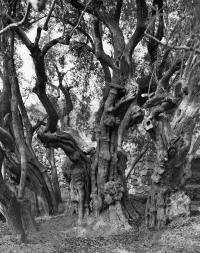
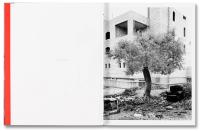
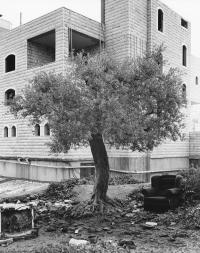
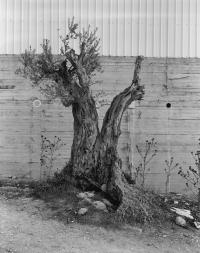
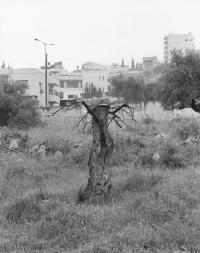
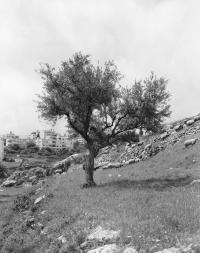
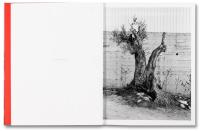
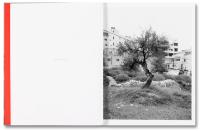
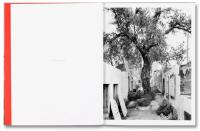











The imagery is strikingly succinct, reminiscent of the stark numerical notations that have haunted us in recent times—numbers representing lives lost to genocide, numbers that reduce the human cost of atrocities to cold data. In contrast, these photographs embody a quieter yet profound response to the violent imagery that floods our media channels. They offer a counter-narrative: one of grace, resilience, and the enduring spirit of a land steeped in deep history and culture. The stark black-and-white palette amplifies this emotional resonance, stripping away distractions to focus on the essence of the scene and the stories embedded within.
Against the grim backdrop of genocide and the pervasive fear that shadows such atrocities, these images evoke a sense of quiet defiance. For an external viewer, they may also open the door to a counter-narrative, a phantasmagoria—a sequence of real and imagined visions that unfold like fragments of a dream. This concept permeates the work, weaving an intricate tapestry of reflection and imagination. The interplay of imagery and coordinates allows for an expanded reading of the narrative, where time collapses yet distances remain intact. It is as if the past, present, and future converge in a single frame, leaving space for the viewer to project their own interpretations onto this evocative visual language.
Through thoughtful sequencing, the images create a loose yet powerful conceptual narrative. The deliberate arrangement reflects a rhythm, a flow that mirrors the organic yet unyielding connection between the land and its people. This flow evokes the timelessness of nature while acknowledging the transitory nature of human struggles. As one image gives way to the next, the viewer is gently guided through a journey that is at once meditative and urgent—a journey that calls for both introspection and action.
Ultimately, the work transcends the boundaries of traditional photography to become a profound meditation on resilience, identity, and the enduring connection to a contested land. The silent strength of these images speaks volumes, bearing witness to the scars of history while celebrating the beauty and spirit that refuse to be erased. The project invites viewers to pause, reflect, and perhaps, in their own way, bear witness to the silent yet resonant stories held within each frame. In doing so, it bridges the gap between the personal and the universal, reminding us of the shared humanity that underpins even the most fractured and exploited narratives.